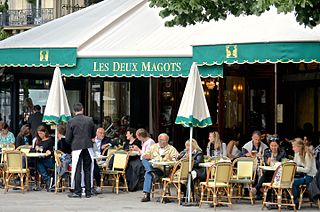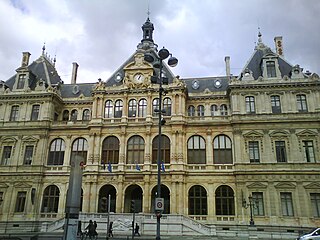
The 6th arrondissement of Paris is one of the 20 arrondissements of the capital city of France. In spoken French, it is referred to as le sixième.

The 2nd arrondissement of Paris is one of the 20 arrondissements of the capital city of France. In spoken French, this arrondissement is colloquially referred to as deuxième. It is governed locally together with the 1st, 3rd and 4th arrondissement, with which it forms the 1st sector of Paris.

Hector Guimard was a French architect and designer, and a prominent figure of the Art Nouveau style. He achieved early fame with his design for the Castel Beranger, the first Art Nouveau apartment building in Paris, which was selected in an 1899 competition as one of the best new building facades in the city. He is best known for the glass and iron edicules or canopies, with ornamental Art Nouveau curves, which he designed to cover the entrances of the first stations of the Paris Metro.
De La Rue plc is a British company headquartered in Basingstoke, England, that produces secure digital and physical protections for goods, trade, and identities in 140 countries. It sells to governments, central banks, and businesses. Its authentication division provides government revenue technology, brand protection, and ID security, such as polycarbonate data pages for passports. Its Currency division designs and produces banknotes, secure polymer substrate and banknote security features. This includes security holograms, security threads and security printed products for central banks and currency issuing authorities. It is listed on the London Stock Exchange. It is the world's largest commercial printer of banknotes.

The Rue du Faubourg Saint-Honoré is a street located in the 8th arrondissement of Paris, France. Relatively narrow and nondescript, especially in comparison to the nearby Avenue des Champs-Élysées, it is cited as being one of the most luxurious and fashionable streets in the world thanks to the presence of virtually every major global fashion house, the Élysée Palace, the Hôtel de Pontalba, the Embassy of Canada, the Embassy of the United Kingdom, as well as numerous art galleries.

Saint-Germain-des-Prés is one of the four administrative quarters of the 6th arrondissement of Paris, France, located around the church of the former Abbey of Saint-Germain-des-Prés. Its official borders are the River Seine on the north, the rue des Saints-Pères on the west, between the rue de Seine and rue Mazarine on the east, and the rue du Four on the south. Residents of the quarter are known as Germanopratins.

The Rue de la Paix is a fashionable shopping street in the centre of Paris. Located in the 2nd arrondissement, running north from the Place Vendôme and ending at the Opéra Garnier, it is best known for its jewellers, such as the shop opened by Cartier in 1898. Charles Frederick Worth was the first to open a couture house in the Rue de la Paix. Many buildings on the street are inspired in design by the hôtels particuliers of Place Vendôme.

The Rue Saint-Honoré is a street in the 1st arrondissement of Paris, France. It is named after the collegial Saint-Honoré church, situated in ancient times within the cloisters of Saint-Honoré.

Mercier denotes the eastern portion of the Mercier–Hochelaga-Maisonneuve borough of the city of Montreal, Quebec. It consists of two neighbourhoods Mercier-Ouest (Longue-Pointe) and Mercier-Est (Tétreaultville).

The Rue de Richelieu is a long street of Paris, starting in the south of the 1st arrondissement at the Comédie-Française and ending in the north of the 2nd arrondissement. For the first half of the 19th century, before Georges-Eugène Haussmann redefined Paris with grand boulevards, it was one of the most fashionable streets of Paris.

The Théâtre de l’Ambigu-Comique, a former Parisian theatre, was founded in 1769 on the boulevard du Temple immediately adjacent to the Théâtre de Nicolet. It was rebuilt in 1770 and 1786, but in 1827 was destroyed by fire. A new, larger theatre with a capacity of 2,000 as compared to the earlier 1,250 was built nearby on the boulevard Saint-Martin at its intersection with the rue de Bondy and opened the following year. The theatre was eventually demolished in 1966.

Barzy-en-Thiérache is a commune in the department of Aisne in the Hauts-de-France region of northern France.
The Théâtre des Variétés-Amusantes was a theatre company in Paris.

The rue de la Victoire is a street in the 9th arrondissement of Paris.

Les Cordeliers is one of the central quarters in the 2nd arrondissement of Lyon, France. It is mainly known for the Place des Cordeliers in its centre. Around the square, there are many notable monuments, including the Église Saint-Bonaventure and the Palais de la Bourse.

The Rue Molière is a short street in central Paris, in the 1st arrondissement. It begins at the Avenue de l'Opéra, near the Comédie-Française, and ends at the Rue de Richelieu with the Fontaine Molière.

The Rue Bonaparte is a street in the 6th arrondissement of Paris. It spans the Quai Voltaire/Quai Malaquais to the Jardin du Luxembourg, crossing the Place Saint-Germain-des-Prés and the Place Saint-Sulpice and has housed many of France's most famous names and institutions as well as other well-known figures from abroad.

The Galerie Vivienne is one of the covered passages of Paris, located in the 2nd arrondissement. It is 176 metres (577 ft) long and 3 metres (9.8 ft) wide. The gallery has been registered as a historical monument since 7 July 1974.

The Passage Jouffroy is one of the covered passages of Paris, located in the 9th arrondissement. It runs between the Boulevard Montmartre to the south and the Rue de la Grange-Batelière to the north.

The Rue Radziwill is a street in the 1st arrondissement of Paris. It starts at 1 rue des Petits-Champs and ends in a dead end. It was named after Polish nobleman and politician Karol Stanisław Radziwiłł.



















